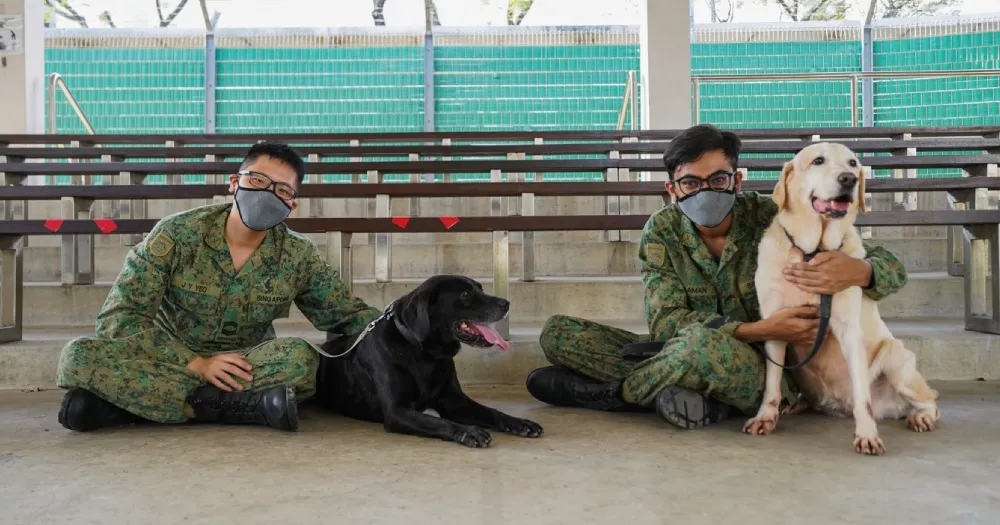军犬训练基地:新加坡武装部队里的快乐天地
我们的故事:基地训犬员告诉我们,这里是服役两年的最佳场所。
|1 min read

<p>还有大约一个月,一等下士 Oliver Yeo 就将服满全日制兵役(NS)。</p> <p>但跟其它大多数即将结束兵役的士兵不一样,Yeo 告诉慈母舰网站,他舍不得离开这里。</p> <p>原因是 Yeo 在新加坡武装部队服兵役的大部分时间都和搭档Jack一起待在军犬训练基地(MWDU)里,而他的搭档Jack,是一只温顺的黑色拉布拉多。</p> <p>Jack 是基地里的嗅探犬,也是 Yeo 的最爱。</p> <p>Yeo 说:“它是我在基地里见过最活力四射的狗。”在 Mowbray 军营军犬训练基地总部的一个训练棚里,这位22岁的年轻士兵接受了我的采访。</p> <p>“我最喜欢的就是带狗狗出去,和它一起玩闹。”</p> <h2>军犬训练基地</h2> <p>军犬训练基地里同时要照顾大约100只狗,通常按工作犬的能力进行分类,例如拉布拉多和猎鹬犬的用途是嗅探犬。</p> <p>另一方面,护卫犬则大多数是德国牧羊犬或者比利时马犬。</p> <p>在过去的日子里,基地里将Jack训练成了能够嗅探炸药和违禁物的嗅探犬。</p> <p>武装部队里的正规兵训练了Jack 两三个月,教它执行简单的命令以及完成任务。</p> <p>训练结束的时候,Jack和其它狗狗还接受了特别的结业检阅。</p> <p><img src="https://imgur.com/M7jxftM.jpg"></p> <p>完成了10周训练的军犬们(新来的护卫犬)参加2019年4月的检阅仪式。图片鸣谢MINDEF。</p> <h2>“绝不是什么轻松的事”</h2> <p>我站在检阅场的围栏外,观看护卫犬 Kita 表演进攻训练。</p> <p>它先是坐在训犬员旁边,直到一声令下,它就飞快跑向另一位迎面而来的训犬员,这位训犬员扮演的是敌人,Kita 接近他之后,从地上一跃而起,死死咬住目标的手臂。当然,训犬员穿着结实的防咬袖套。</p> <p>又听见几声命令后,这只比利时马犬已经乖乖坐回了训犬员的脚边。</p> <p>在训练基地里,所有的新手训犬员都要参加军犬的进攻训练,也就是给它们当靶子。</p> <p>下士 Shaaman Srikath 至今仍记得他第一次站在检阅场中间,穿着防咬袖套时的心情。</p> <p>他告诉我:“我一直觉得自己特别勇敢。”</p> <p>“但狗真的冲你扑来的那一刻,绝不是什么轻松的事。”</p> <p>尽管如此,这位20岁的年轻人很快补充道,这个训练其实相当安全。</p> <p>“我们的狗都是非常训练有素的……它们知道怎么和新手训犬员相处,大多数时候,他们比新训犬员表现还要好。”</p> <h2>和狗狗建立感情</h2> <p>看到护卫犬面相凶猛,戴着口套发出低沉的吼叫声,狗绳绷得笔直,这给我留下了深刻的印象,很难想象 Shaaman 竟然说他们“很亲人”,除非你和它们建立起很好的感情。</p> <p>对于这些精力旺盛的狗狗,他表示:“就因为这样他们才大有用途。”</p> <p>“在你经常带狗出去玩,学会跟它们相处,跟他们建立感情的过程中,你对它们的看法就会慢慢改变,它们也会逐渐亲近你。”</p> <p>根据 Yeo 和 Shaaman的说法,和狗建立感情的过程可能长达两个月。</p> <p>军犬训练基地里的每一个训犬员最多会有三只狗,日常和他们一起工作。</p> <p>训犬员每天都要把狗从狗舍里牵出来喂食、锻炼、洗澡、梳毛和训练。</p> <p>他们还要花时间打扫狗舍,带着这些毛茸茸的小伙伴出去玩。</p> <p>Shaaman 说,诸如此类的每一项活动,都是和狗狗建立感情的好机会。</p> <p>Yeo 和 Jack 建立起感情,是这位士兵发现 Jack 开始对自己亲近起来的时候。</p> <p>“如果其他人要带 Jack 出去,他就会快速向我跑来,不理其他训犬员。有时候如果我去做其他事没时间管它,它就会冲着我叫,想引起我的注意,让我回到它身边。”</p> <p><img src="https://imgur.com/22TMvh9.jpg"></p> <p>Yeo 和 Jack。Andrew Koay 摄。</p> <h2>“不用我说,他也知道要做什么。”</h2> <p>与狗建立感情不仅能创造温暖的氛围,也能减轻训练和操作中训犬员的工作负担。</p> <p>Shaaman 解释说:“你甚至不用喊出全部命令就能完成任务。”他主要训练的狗是一只庞大的德国牧羊犬,名叫 Arras,这也是他最爱的狗。</p> <p>Shaaman 回忆起有一次他和 Arras 在新手训犬员面前示范一系列训练动作,他想知道在这些完全陌生的新手面前,这只德国牧羊犬还会不会乖乖听话。</p> <p>“就是那时候,我发现自己和 Arras 建立起感情了。我不用说出完整的命令,也不用做完整的手势,只要手轻轻动一下,或者发出一点声音,他就已经知道该做什么了,而且做得很好。”</p> <p>训练军犬还很大程度上取决于训犬员的性格和技巧。Yeo 告诉我,一些比较狡猾的狗有时候会围着缺乏经验的士兵兜圈子。</p> <p>“根据你训练他们的方式,狗也会有不同的反应。如果有的训犬员训练方式不正确,有些狗是会乘机利用训犬员的。”</p> <h2>退休和领养</h2> <p>Yeo 还是基地里的助理兽医,我围观了他给 Jack 进行身体检查,这只拉布拉多听话地跟着训犬员去兽医室,看得出他们之间有很深的感情。</p> <p>Yeo 和这只大狗说话的时候轻言细语,就像与人交谈一般,狗在他面前也是不可思议地温顺。</p> <p>Jack 已经是一只九岁的老狗了,现在正在安享退休生活。</p> <p>狗狗们通常在一岁时来到军犬训练基地,然后工作到八岁左右。</p> <p>狗退休以后,基地会通过部队每年举行的领养活动帮助他们寻找新家。</p> <p>在这期间,训犬员会把狗狗们打扮得干净漂亮,帮助他们准备好迎接幸福晚年。</p> <p>没有被领养的狗会继续在基地里接受训犬员的照顾。</p> <p>Yeo 说起他即将结束的兵役和 Jack 可能离开基地的事时,说:“要和这只狗分开,我肯定会伤心的。”</p> <p>但我很高兴这些狗能够退休,因为他们会找到充满爱的新家,沐浴在爱和关怀之中。</p> <p>况且他们已经在军中服务了六年甚至更长的时间,他们值得受到关爱。”</p> <p>Yeo 说他希望以后还能去 Jack 的新家探望他。</p> <h2>军中最快乐的部队</h2> <p>同时,Shaaman 双腿交叉坐在地板上,Arras 的头枕在他的腿上。</p> <p>现在是梳毛的时间,Shaaman 正帮 Arras 把他黑金相间的皮毛上多余的毛梳下来。</p> <p>在梳毛区外面,一位有望领养 Arras 的人将这些画面尽收眼底。我得知这位高大魁梧的纹身男以前也是一名训犬员。</p> <p>Shaaman 还要在军队里服役一年左右,但是他已经对未来有了激动人心的规划。服役结束后,他要去海外的大学继续深造学习。</p> <p>不过现在,他正在尽情体会在基地里与狗狗共度的每分每秒。</p> <p>“在这里没有悲伤的日子。”他说。</p> <p><img src="https://imgur.com/cLHno9n.jpg"></p> <p>图片来自 Andrew Koay</p> <p>《我们的故事》是一系列以新加坡普通人和他们不寻常的生活为主题的故事,不论是打破常规、追求独特爱好还是分享奋斗经历,这些故事都让我们领悟到每个人的不同寻常和集体的人性光辉。</p> <p>置顶图片来自 Andrew Koay</p>

